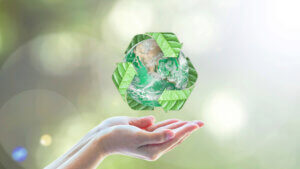Packaging formats & materials that make a difference – and those to be mindful of
Roger Wright, Waste Strategy and Packaging Manager at waste management company Biffa
Packaging is perfectly primed to catch the eye of a consumer. Studies into the psychology behind purchase decisions reveal that aesthetics and feel are key motivators. Consumers may (consciously or unconsciously) seek out a colour and cue associated with a brand or, increasingly, more sustainable materials (like choosing paper over plastic for their favourite products in store).
To help fulfil the needs of both your end-user and any stockists selling your product in an increasingly eco-conscious world, it’s therefore worth carefully considering your choice of packaging along with a host of other critical features that follow.
Ideally, the materials used enter the ‘circular economy’ where they can be continually reused, refurbished, regenerated or recycled for as long as possible within a closed loop. Even the most circular materials have a limited lifespan and will eventually no longer be optimal. It’s also worth considering that reusable packaging is not always recyclable – so choosing recyclable materials for these too, is often better.
The biggest challenge of course is ‘single use’, which has a short, one-time lifespan. Single use (or containing single use) characterises many types of packaging, in many materials, and which can drive waste and therefore carbon emissions up, as virgin materials are necessary to replace used goods.
Changes are necessary at all stages of the circular economy – but conscious decisions about packaging material choices can be made today and is key to becoming a more sustainable business. Using sustainable packaging materials will also prevent consumers from ‘wishcycling’, where waste is placed in recycling bins incorrectly.
That’s why Biffa are helping businesses to understand the sustainable packaging options available. It can feel overwhelming and confusing – particularly when some materials are (incorrectly) perceived to be kinder to the planet. Understanding which packaging types can (and can’t) enter the circular economy and in what context means you can make well informed sustainable changes – or at least feel reassured you’re on the right track.
To help you make those difficult choices I’m sharing seven steps to sustainable (packaging) heaven to ease you through the process.
1. Packaging’s origin story
Consider whether the packaging is necessary in the first place. Challenge your supplier and refuse to accept extra packaging if you don’t think it necessary. Ensure that any extra packaging is sustainably sourced.
2. The product or service
Check the sustainable credentials of the product or service being packaged to avoid getting caught out for exaggerating any eco-friendly claims.
3. The supply chain
Find out who has physically made your packaging, if their employees are fairly treated, and how far the pack has travelled. Consider whether the finished product or service is under or over packaged for the channel it’s being sold in.
4. Retail therapy
How does the packaging make you feel? Does it bring you joy? Would your customer want to keep it, even after it has served its purpose? Try to understand consumers’ psychological decisions behind picking your product.
5. Functionality
How efficient is the packaging at doing what it was designed for, and will it meet the requirements of inclusivity?
6. The circular economy
Does the packaging meet the requirements of the circular economy and can this pack – by its very existence – help the end user think or act more sustainably in other ways?
7. End of Life
Bring it back to basics – is the packaging widely recyclable (by which we mean widely collected, sorted AND recycled) or could a reusable version of the same product have worked just as well?
Recommended packaging options:
Plastic bottles with clear or natural-coloured caps
There are lots of ways to recycle clear or natural-coloured plastics into other similar products, lengthening their lifespan in the circular economy. Coloured plastic – while still recyclable – is only downcycled into a darker shade, which limits its life span. A consideration might be that your brand is associated with a certain colour, however there are lots of other ways to get creative with the formats, to secure sustainability and maintain your presence on shelf.
Metal and aluminium containers
This type of packaging – like for tinned food and fizzy drinks – are excellent packaging materials when used in context. Firstly, it’s incredibly strong and stable in the supply chain. Secondly, it helps to preserve the product for a long time and contain pressurised drinks successfully. It’s stackable, easy to store, and it can be infinitely recycled within a closed loop regardless of how heavily its printed.
Compostable carrier bags
Some UK food retailers have launched bio-based and compostable bags, for when their customers forget to bring a reusable alternative. They are made from renewable materials strong enough to be reused, but when no longer useful for shopping, can be reused as a caddy liner for food waste, as a bin bag safe in an industrial composting system or in general waste (without leaving micro plastics behind). However, this type of packaging is only optimal when composted, not recycled. If a compostable bag was put in with your dry mixed recycling, it risks contaminating all the other recyclables within, spoiling the whole batch.
Paperboard boxes
Commonly used around packs of cereal, pasta and other dried goods, paperboard is thicker than paper but, unlike corrugated cardboard, made from just one layer. It’s strong enough to display these items on shelf and through the supply chain, yet thin enough to be extremely efficient at its job. It can be recycled in paper and card bins, therefore entering the circular economy. Its recyclability can, however, be spoiled if contaminated with food scraps or liquid, contaminating other recyclables and missing the opportunity to go back into a closed loop.
Plastic pots, tubs and trays
There are seven different types of plastic. If you’re keen to use plastic, rigid PET and Polypropylene (PP) are widely recyclable. As well as drinks bottles, PET is prevalent in foods trays. It’s durable, widely recyclable, can contain recycled content and is carbon efficient. Not only can it be recycled into new food-safe packaging containers, but even fabrics and furniture. PP is the second most widely used rigid plastic but cannot currently be upcycled back into food-safe formats. Because it tolerates a high heat, it’s very efficient and robust in any supply chain.
Packaging to re-consider:
Plastic single use or refillable pouches
The range of refillable formats (often for soap and cleaning products) has increased. Pouches for refill into other bottles are common forms, with consumers perceiving both as an environmentally friendly option. On the face of it, the ‘re-use’ factor of the bottle is appealing and valid, however the pouches themselves cannot be recycled as they are multi-material and multi-layered to protect the product inside.
Plastic-lined paperboard cartons
Drinks cartons may look and feel like a good option due to their similarity to cardboard. In reality, they’re more problematic than plastic bottles. Two factors reduce their recyclability; they’re made up of a mix of different materials so are harder to separate in the recycling process and often get confused for recyclable paperboard material, causing contamination.
Foil bags
‘Foil-like’ bags (such as crisp packets) are an issue within regular recycling because whilst they look like foil, they are actually just a metallised plastic film. These packets are therefore a hybrid of different plastics, which aren’t easily recycled.
Glass bottles
The great thing about glass is that it can be recycled many times within a closed loop (ie. smashed, melted and re-produced into a new item) or even refilled. This makes it appear to be better than plastic and other equivalent formats. However, the cost of manufacturing glass carries a particularly high carbon footprint due to the original process of manufacture, as well as in the remanufacture when recycled. It’s often a less sustainable option as a refill due to the combination of its weight and the long distances it may travel.
Adopting sustainable packaging options for your business will mean avoiding waste in the first place. If you make sure more of the waste you do generate can be reused or recycled, these two factors will help you reach those all-important sustainability goals and ultimately protect the planet.
Consumers are more eco-conscious than ever, even choosing lesser-known sustainable brands over household names with less environmentally friendly attributes.
Simply switching out one material for another or changing the format completely could have a considerable positive bearing on your company’s sustainability credentials in the long run but make those changes carefully because even reusable and refillable formats aren’t always recyclable.
Often forgotten is that adapting your business model and its packaging to support the circular economy will attract more sustainability-minded talent into your business as well as helping you to grow by boosting sales. There’s never been a better time to prioritise packaging.
Biffa has produced guides for consumers and businesses to promote better recycling:
- The most commonly wishcycled items
- The seven different types of plastic
- Recycling symbols explained






